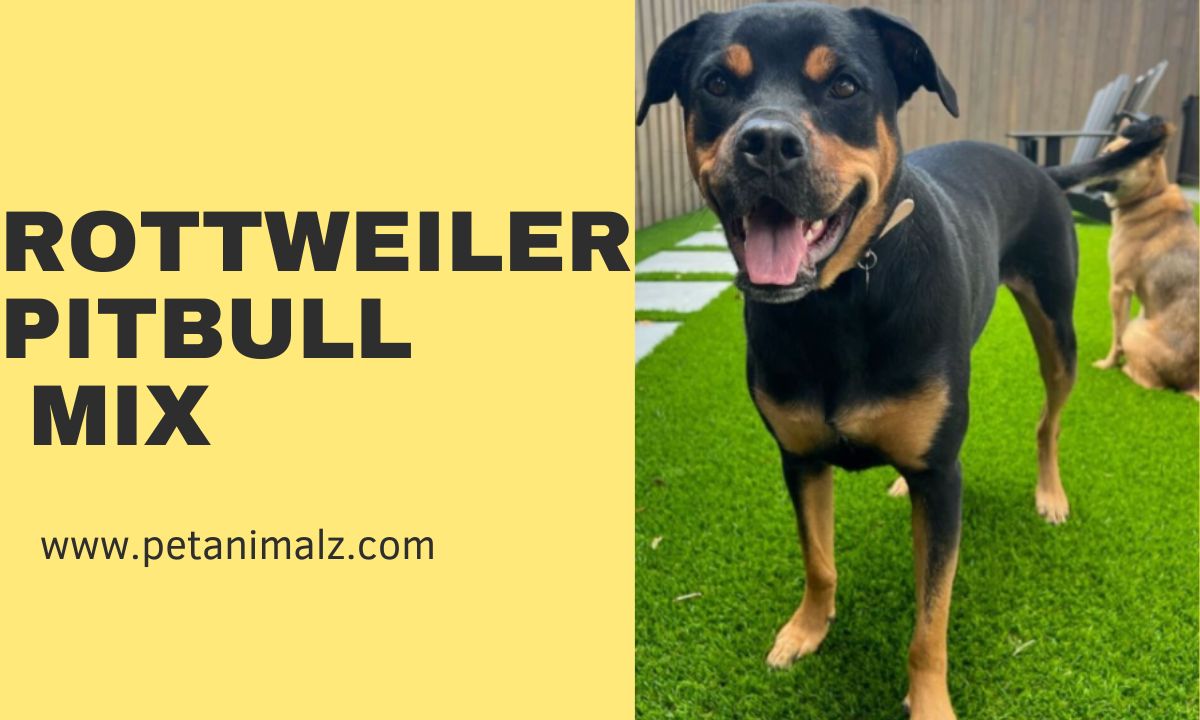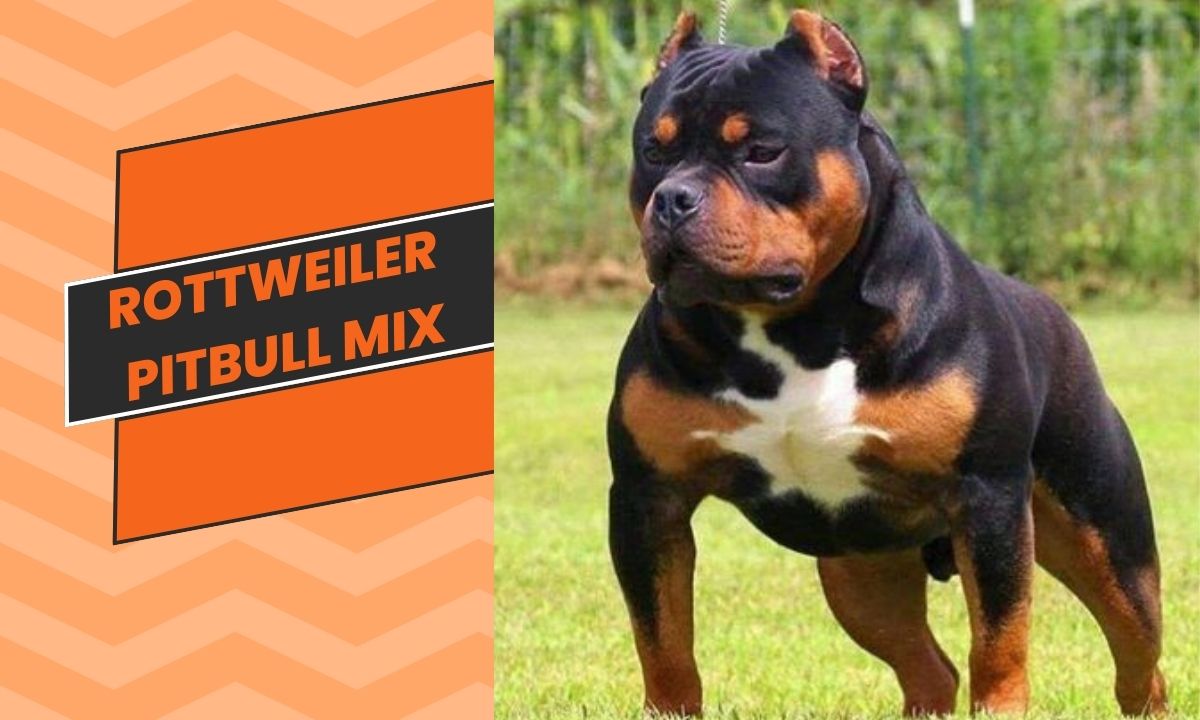Rottweiler Pitbull Mix : Complete Guide
This article provides complete information about Rottweiler Pitbull Mix. The Rottweiler Pitbull Mix, affectionately known as the Pitweiler, is a unique blend of two powerful and distinct breeds. This hybrid dog captures the essence of both its parent breeds, resulting in a pet that’s both energetic and loyal.
Introduction of Rottweiler Pitbull Mix:
The Pitweiler is not just another breed; it’s a testament to the beauty of crossbreeding. By merging the strength and resilience of the Rottweiler with the tenacity and spirit of the Pitbull, we get a dog that’s both formidable and affectionate.
Rottweiler:
Origin:
The Rottweiler traces its roots back to ancient Rome. They were descendants of the Molossus, a mastiff-type dog that the Romans used for herding and guarding livestock as they traveled across Europe.
Development in Germany:
The breed further developed in a German town called Rottweil, from which it got its name. In Rottweil, these dogs were used to herd livestock and pull carts laden with butchered meat to market. Their strength, endurance, and protective nature made them invaluable to butchers, leading to the nickname “Butcher’s Dog.”
Modern Role:
Over time, as industrialization reduced the need for herding dogs, Rottweilers transitioned to roles in police work, search and rescue, and as loyal family companions.
Pitbull:
Origin:
The term “Pitbull” is a bit of a misnomer, as it often refers to a group of breeds, including the American Pit Bull Terrier, American Staffordshire Terrier, and sometimes the Staffordshire Bull Terrier. These breeds have their origins in the UK.
Early Roles:
Initially, these dogs were bred for bull-baiting, a popular sport where dogs were set upon a tethered bull. The name “Pitbull” comes from their role in this sport, as it often took place in pits.
Transition to America:
When bull-baiting was banned in the 1800s, these dogs were bred for a new, unfortunate role in dog fighting. Many were brought to America by immigrants, where they transitioned from fighting dogs to farm dogs, helping with hunting, guarding, and being family companions.
Modern Perception:
Despite their controversial past, many Pitbulls today are cherished family members known for their affectionate nature, intelligence, and loyalty. However, they still face breed-specific legislation and misconceptions in many places.
Importance:
For potential owners, diving into the world of the Pitweiler is no small feat. It’s essential to understand:
- The breed’s unique characteristics set it apart.
- The care needs that come with owning such a dynamic dog.
- The potential challenges that might arise, given its strong lineage.
By understanding these aspects, owners can ensure a harmonious relationship with their Pitweiler, cherishing the joy it brings while being well-prepared for its demands.

The Rottweiler Pitbull mix –Colors and pattern
Certainly! The Rottweiler Pitbull mix, often referred to as the Pitweiler, is a hybrid breed that inherits physical traits from both its parent breeds. As a result, the colors and patterns of a Pitweiler can vary widely. Here’s a breakdown:
Colors:
The Pitweiler can come in a range of colors, often influenced by the dominant genes of the parent breeds. Some common colors include:
- Black: A dominant color, especially if the Rottweiler genes are strong.
- Brown or Tan: Often seen in patches or as the primary color.
- Brindle: A mix of dark and light stripes, inherited from the Pitbull side.
- Blue: A rarer color, but possible due to the color variations in Pitbulls.
- White: Less common, but some Pitweilers may have white markings or patches.
- Fawn: A light tan or pale brown color.
Patterns:
The patterns on a Pitweiler can be as varied as the colors. Some common patterns include:
- Solid: A single color without any significant markings or patches.
- Tuxedo: Predominantly one color with a white chest and possibly white paws.
- Pied: Large patches of one color on a white base.
- Masked: A darker coloration on the muzzle, often seen in Rottweilers.
- Points: Darker color on the ears, muzzle, paws, and tail, reminiscent of the Rottweiler’s markings.
It’s essential to note that due to the mixed-breed nature of the Pitweiler, predicting the exact color and pattern of puppies can be challenging. Each dog is unique, and their appearance will be a blend of both parent breeds. Regardless of their color or pattern, Pitweilers are known for their robust and muscular physique, combined with a loyal and affectionate temperament.
Understanding the Rottweiler Pitbull Mix
History and Origin of the Rottweiler Pitbull Mix
The Rottweiler Pitbull Mix is a blend of two ancient and revered breeds.
- Brief history:
- The Rottweiler traces its roots back to the Roman Empire, serving as herding and guarding dogs.
- The Pitbull, on the other hand, has its origins in the UK and was initially bred for bull-baiting before evolving into a farm dog in the US.
- Reasons for crossbreeding:
- To combine the strength and loyalty of the Rottweiler with the tenacity and affection of the Pitbull.
- To produce a versatile dog suitable for protection, companionship, and work.
Appearance, Personality, and Traits
The Pitweiler is a sight to behold, boasting a blend of its parents’ best features.
- Physical characteristics:
- Weight: Typically between 40-100 lbs.
- Height: Ranges from 18 to 25 inches.
- Coat type: Short to medium length, dense.
- Color: Varies from black, brown, brindle, or a mix.
- Temperament:
- Affectionate: Known for their love for family.
- Confident: They carry themselves with pride.
- Loyal: Fiercely devoted to their owners.
- Dominant tendencies: Need a firm hand in training.
Pros and Cons of Owning a Rottweiler Pitbull Mix
Every breed has its highs and lows, and the Pitweiler is no exception.
Pros:
- Strong and protective nature makes them excellent guard dogs.
- Their affectionate demeanor makes them great companions.
- Highly intelligent and trainable.
Cons:
- Their dominant nature requires experienced handling.
- Potential health issues inherited from both parent breeds.
- May not be suitable for first-time dog owners.
Health Concerns and Care
Like all breeds, the Pitweiler has its set of health concerns.
- Common health issues:
- Addison’s Disease
- Heart problems
- Bloat
- Cataracts
- Allergies
- Joint problems
- Regular vet check-ups are crucial to catch and address issues early.
Dietary Needs
Feeding a Pitweiler requires attention to their unique needs.
- Recommended food types: High-quality dry kibble, raw diet.
- Brands: Look for those without fillers or by-products.
- Caloric and nutritional requirements vary based on age, weight, and activity level.
Exercise and Training Requirements
A healthy Pitweiler is an active one.
- Daily exercise is crucial: Walks, playtime, or agility training.
- Training tips: Start early, be consistent, and use positive reinforcement.
- Socialization is key, especially when young.
Grooming Needs
Keeping a Pitweiler looking its best is straightforward.
- Regular brushing to manage shedding.
- Ear cleaning and nail clipping.
- Dental care: Regular brushing or dental chews.
Rottweiler Pitbull Mix and Families
Is the Pitweiler right for your family?
- Generally good with children, especially if raised with them.
- Require space to move, a yard is ideal.
- Need consistent training and boundaries.
FAQs
How long does a Pitweiler live?
Typically 12-15 years.
Are they aggressive?
With proper training and socialization, they’re loving and protective.
How big do they get?
Size varies, but most are medium to large.
· Are Pitbull Rottweiler mix good dogs?
Yes, the Pitbull Rottweiler mix, often referred to as the Pitweiler, can be an excellent dog when raised with proper training, socialization, and care.
They are known for their loyalty, intelligence, and protective nature. However, they require an experienced owner who can handle their strong and dominant tendencies.
What does a pitbull rottweiler look like?
A Pitweiler typically has a muscular and robust build, combining features from both parent breeds. They can have a short to medium-length coat that varies in colors like black, brown, brindle, or a mix. Their face may resemble either a Rottweiler or a Pitbull, or a blend of both.
Which is bigger, rottweiler or pitbull?
Generally, Rottweilers are bigger than Pitbulls. Adult male Rottweilers can weigh between 95-135 lbs, while female Rottweilers weigh between 80-100 lbs. In contrast, Pitbulls usually weigh between 30-85 lbs, depending on the specific type of Pitbull.
Are Rottweilers a type of pitbull?
No, Rottweilers and Pitbulls are distinct breeds with different histories and characteristics. While both are often lumped into the “bully breed” category due to their muscular appearance, they are not the same.
Which is the strongest dog?
The term “strongest” can be subjective, depending on whether you’re referring to bite force, endurance, or physical strength. Breeds like the Mastiff, Saint Bernard, and Rottweiler are often considered among the physically strongest.
What dog has the strongest bite?
The Mastiff holds the title for the dog with the strongest bite force, measured at over 500 pounds of pressure. Other breeds with strong bites include the Rottweiler, Kangal, and Dogo Argentino.
Which dog can defeat Pitbull?
It’s essential to note that promoting dog fights is inhumane, illegal, and unethical. However, in terms of strength and bite force, breeds like the Kangal, Dogo Argentino, and Cane Corso are often considered more powerful than the Pitbull.
Who bites harder, pitbull or Rottweiler?
In terms of bite force, the Rottweiler has a stronger bite than the Pitbull. A Rottweiler’s bite force is around 328 pounds of pressure, while the Pitbull bite force is around 235 pounds of pressure.
Conclusion:
The Pitbull Rottweiler mix, or Pitweiler, is a blend of two powerful and distinct breeds, each with its unique history and characteristics.
While both breeds have faced their share of misconceptions and challenges, they are known for their loyalty, intelligence, and protective nature when raised in the right environment. Like all dogs, they thrive best with proper training, socialization, and care.
It’s essential to remember that every dog, regardless of its breed, is an individual with its own personality and temperament.
The key to a harmonious relationship with any dog lies in understanding its needs, providing consistent training, and offering unconditional love.
Whether it’s a Rottweiler, a Pitbull, or a mix of the two, every dog deserves a chance to be a beloved family member.



